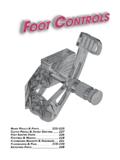Transcription of Wiring A Tortoise Switch Machine for the Mainline
1 Los Angeles Model Railroad Society Wiring A Tortoise Switch Machine for the Mainline Ira Abramowitz 2/27/2010 2 1 INTRODUCTION ..3 LET S START ..3 2 MECHANICAL MOUNTING ..4 MECHANICAL MOUNTING OPTIONS ..4 TURNOUT CRANKS ..4 MECHANICAL MOUNTING ..4 3 POWER THE Tortoise ..6 IMPORTANT NOTE FOR CONNECTING TO Tortoise ..6 WIRE GAUGE ..6 MARK ONE SIDE OF THE Tortoise AND CONNECTOR ..6 PIN NUMBERING ..6 WIRE COLORS ..6 BRING POWER FROM SE8C TO Tortoise ..7 TEST THE PIN 1 AND 8 POLARITY ..7 LED MODULE ..7 INSTALLATION OF LED INTO FASCIA ..8 WIRE THE CHECK THE FROG Wiring .
2 9 FINAL TEST ..9 APPENDIX 1, Tortoise WIRE BENDING GUIDE .. 10 APPENDIX 2, PRIMARY LED MODULE .. 11 APPENDIX 3, POWER MODULE .. 12 APPENDIX 4, ALTERNATE LED MODULE .. 13 APPENDIX 5, ALTERNATE POWER MODULE .. 14 3 1 Introduction You are starting a great adventure. You will be well prepared if you first read these directions in their entirety. If you use Stan s mount (see later), build the LED module described in Appendix 2. Build the Power Module, Appendix 3, and then pre-wire the Tortoise connector with Power and Frog connections. An alternate LED and Power Module are described in Appendices 4 and 5.
3 These are for use with the Tortoise Remote Mount. Let s Start You are replacing an existing Mainline Switch Machine whose electrical connections are proper, but whose mechanical elements are out-of-whack. A Mainline Machine has several characteristics: 1. It may be operated by a fascia-mounted push button 2. It is addressable by a DT400-402 using the address shown on the fascia 3. It is powered by an SE8C 4. It has a powered frog Confirm that this is true. Switch machines in the yard may be replaced by similar techniques, but at present, these machines are powered from a DC power supply. Here, the polarity of the DC to the Machine is switched by a panel-mounted DPDT toggle Switch .
4 Not all frogs are power switched in yards. Remove the Existing Switch Master Switch Machine Switch Motor Power Turn off Track power. Then identify and mark the power leads to the existing Switch Master (black cylinder) Machine . These are the two leads (from the SE8C for Mainline turnouts) that attach to solder terminals at the bottom of the motor from the SE8C. Usually, there are voltage-dropping resistors in series with one or both of the leads. These resistors are no longer needed. Frog Power Frog power comes from the stock rails of the turnout (the fixed outside rails). We are going to identify these leads and remove them from the existing motor.
5 The motor is supported from the layout by two screws, each passes through the motor and a plastic stud. Now, while holding the motor, detach it carefully from the layout. Three leads are still connected to micro-switches at the top of the motor. These leads are used to power the frog. Carefully de-solder or cut these leads at the terminals of the micro- Switch . The motor and mounting hardware are no longer needed. 4 Identify and mark the two leads that from the stock rails, which power the frog, and the lead that goes to the frog itself. These were attached to the two micro-switches. Note, that one of these leads also is attached to the fascia LED.
6 This branch to the LED is no longer needed. 2 Mechanical Mounting Mechanical Mounting Options Tortoise machines may be mounted by many methods and in various configurations. Specifically the voltage polarity (between Tortoise pins 1 and 8) to drive a Tortoise to the through, t , (or diverging) route is difficult for me to figure out at this stage of the installation. I play it loose and am prepared to swap the wires. Similarly, I would not install the LED into the fascia until instructed in paragraph (or else be prepared to swap wires here too) Lastly, be prepared to swap the feed wires that power the frog.
7 Turnout Cranks If new cranks are needed, use piano wire (K & S part #1143) for the crank and 16-inch brass tubing (K & S part #501) for the tubing into which the crank passes vertically from the throw bar to the under-roadbed. There is a metal form for shaping the crank. ASK FOR IT! Mechanical Mounting Mount the Tortoise Machine and hand test it for smoothness of control by slowly moving the mechanism manually (see Tortoise instructions 800-6000, enclosed). I have also included the instructions for the Remote Tortoise Mount (800-6010). In any case, make sure that the points are centered when the Tortoise is in the middle of its throw.
8 Stan has provided various mounting configurations and I have tried his retro-fit design. I can recommend it. I have also devised an alternate to Stan s concept that does not require a wooden block. This approach provides less throw than Stan s because there is no block. Similarly, he throw is also less than the Tortoise -provided concept wherein the actuator rod passes through the roadbed. I used this alternate during the installation of the four Tortoise machines at Joliet Junction and the throw was sufficient. Notes for Ira s Modification to Stan s Mount 1. Center the points on the turnout. I use tooth picks or blue tape.
9 5 2. Bend the under-layout portion of the crank to the vertical. It should be about -inch below the sub-roadbed. 3. Check for smooth action of the crank 4. I cut the under-layout portion of the crank to about inches from the tubing. 5. Build a shepherd s crook (see photo and diagram) from piano wire (K & S part #497). The top of the crook should reach the top of the Tortoise when the Tortoise is centered in its throw. The top of the crook is about -inch forward of the lower part of the crook (see second photo). See the bending guide in Appendix 1, Tortoise Wire Bending Guide. 6. The hole above the bright screw needs to be opened with a #60 drill ( ).
10 The fulcrum hole is just fine. 7. Start with the Tortoise fulcrum near its maximum throw adjustment. 8. Apply heavy duty foam double-sided tape to the top of the Tortoise (red piece in photo). If you clean the sub-roadbed first (sticky tape works well), then you can adjust the Machine for best position. The tape allows you to manually or electrically power the Tortoise to test the throw. 9. Adjust the fulcrum as required. 10. Gently screw the Tortoise to the sub-roadbed, leaving the tape in place. 11. Affix the fulcrum with some Blue Tack (gray stuff in the photo) or other removable adhesive when finished.








